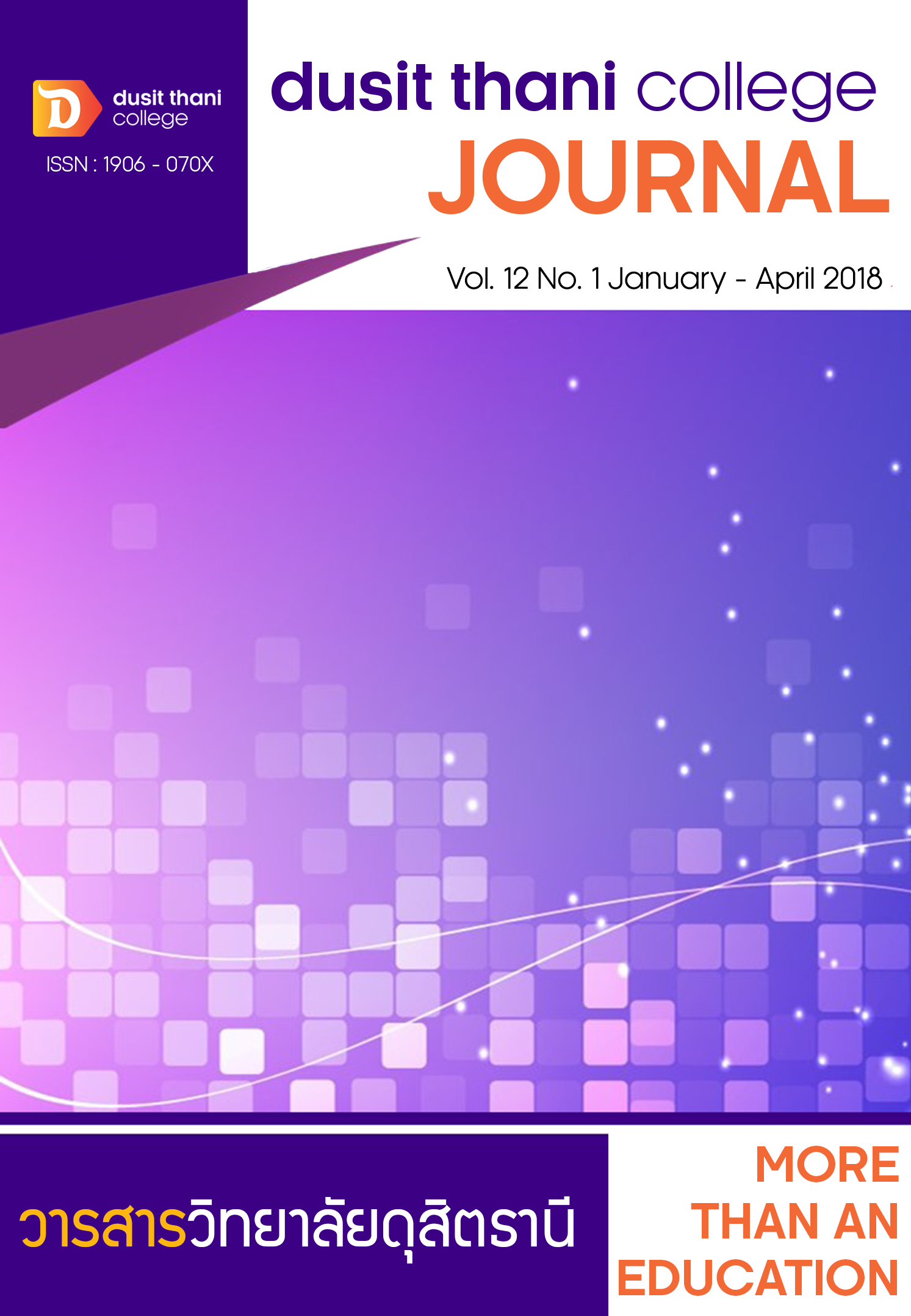การพัฒนาผลิตภัณฑ์ชุมชนเพื่อเข้าสู่ตลาดธุรกิจโรงแรม จังหวัดเชียงราย
Main Article Content
บทคัดย่อ
การวิจัยครั้งนี้ มีวัตถุประสงค์เพื่อ 1) สำรวจและวิเคราะห์ศักยภาพของผลิตภัณฑ์ชุมชนเพื่อการพัฒนาเข้าสู่ตลาดธุรกิจโรงแรม จังหวัดเชียงราย 2) พัฒนาผลิตภัณฑ์ชุมชนโดยผ่านกระบวนการมีส่วนร่วมของชุมชนเพื่อการพัฒนาเข้าสู่ตลาดธุรกิจโรงแรม จังหวัดเชียงราย และ 3) เพื่อประเมินผลการนำผลิตภัณฑ์ชุมชนที่ได้รับการพัฒนาเข้าสู่ตลาดธุรกิจโรงแรม จังหวัดเชียงราย โดยนำแนวคิดและทฤษฎีการมีส่วนร่วมของชุมชน การพัฒนาผลิตภัณฑ์และการตลาดธุรกิจโรงแรม มาเป็นกรอบแนวคิด เป็นการวิจัยแบบผสมทั้งเชิงคุณภาพและปริมาณ เครื่องที่ใช้ในการวิจัยแบ่งออกเป็น 2 ส่วน คือ 1) แบบสัมภาษณ์แบบกึ่งโครงสร้าง โดยทำการเก็บรวมรวมข้อมูลจากการสำรวจและการสัมภาษณ์เพื่อดำเนินการสัมภาษณ์ผู้ให้ข้อมูลหลัก (Key Informant Interview) ในชุมชนเพื่อวิเคราะห์ศักยภาพของผลิตภัณฑ์ชุมชนและความต้องการของชุมชนในการพัฒนาผลิตภัณฑ์เพื่อเข้าสู่ตลาดธุรกิจโรงแรม และ 2) แบบสอบถามเพื่อสำรวจความพึงพอใจการพัฒนาผลิตภัณฑ์ชุมชนโดยผ่านกระบวนการมีส่วนร่วมของชุมชนเพื่อการพัฒนาเข้าสู่ตลาดธุรกิจโรงแรม จังหวัดเชียงราย และเพื่อประเมินผลการนำผลิตภัณฑ์ชุมชนที่ได้รับการพัฒนาเข้าสู่ตลาดธุรกิจโรงแรม จังหวัดเชียงราย
ผลการวิจัยพบว่า
ผลการวิจัยตามวัตถุประสงค์ 1) จากการสำรวจและวิเคราะห์ศักยภาพของผลิตภัณฑ์ชุมชนเพื่อการพัฒนาเข้าสู่ตลาดธุรกิจโรงแรม จังหวัดเชียงรายพบว่า สำนักงานมาตรฐานผลิตภัณฑ์อุตสาหกรรม (2559) ได้ทำการสำรวจผลิตภัณฑ์ชุมชนของอำเภอเชียงแสน จังหวัดเชียงราย ซึ่งเป็นการสำรวจและวิเคราะห์ศักยภาพของผลิตภัณฑ์ โดยข้อมูลผลิตภัณฑ์นำมาจากสำนักบริหารมาตรฐานผลิตภัณฑ์ชุมชน การรับรองคุณภาพผลิตภัณฑ์ชุมชน (มผช.) เป็นการให้การรับรองคุณภาพผลิตภัณฑ์ชุมชนของผู้ผลิตในชุมชนตามมาตรฐานผลิตภัณฑ์ชุมชน ที่สำนักงานมาตรฐานผลิตภัณฑ์อุตสาหกรรม ได้ประกาศกำหนดไว้ สรุปผลการสำรวจศักยภาพชุมชนที่มีผลิตภัณฑ์ตรงกับความต้องการของลูกค้าของโรงแรมได้แก่ ผลิตภัณฑ์จากผ้า ดังนั้นคณะผู้วิจัยจึงเลือกกลุ่มทอผ้าบ้านทุ่งฟ้าฮ่ามและกลุ่มทอผ้าบ้านสันธาตุ อำเภอเชียงแสน จังหวัดเชียงราย ซึ่งเป็นชุมชนทอผ้าไหมและที่ได้รับเครื่องหมายรับรองผลิตภัณฑ์ผ้าไหมไทย “นกยูงสีเงิน” ตรานกยูงพระราชทาน โดยกรมหม่อนไหม 2) การพัฒนาผลิตภัณฑ์ชุมชนโดยผ่านกระบวนการมีส่วนร่วมของชุมชนเพื่อการพัฒนาเข้าสู่ตลาดธุรกิจโรงแรม จังหวัดเชียงราย พบว่า มีทั้งที่สอดคล้องและไม่สอดคล้อง โดยพบว่า ในขั้นตอนของการพัฒนาผลิตภัณฑ์ชุมชน มีความคิดเห็นเกี่ยวกับบรรจุภัณฑ์ที่ไม่ค่อยแข็งแรง รวมทั้งการใช้สอยและ 3) เพื่อประเมินผลการนำผลิตภัณฑ์ชุมชนที่ได้รับการพัฒนาเข้าสู่ตลาดธุรกิจโรงแรม จังหวัดเชียงราย พบว่า จากผลความพึงพอใจในด้านการพัฒนาผลิตภัณฑ์เข้าสู่ธุรกิจโรงแรม ด้านคุณภาพผลิตภัณฑ์พบว่า มีความพึงพอใจเฉลี่ยสูงที่สุด ผลการศึกษาในการประเมินความพึงพอใจผลิตภัณฑ์ชุมชนเข้าสู่ธุรกิจโรงแรมพบว่า การส่งเสริมการตลาดและบรรยากาศของแหล่งจำหน่ายผลิตภัณฑ์ สร้างความพึงพอใจต่อนักท่องเที่ยวในระดับมาก กลุ่มผู้วิจัย มีข้อเสนอแนะในการทำวิจัยในครั้งต่อไปว่าในการกระบวนการมีส่วนร่วมพัฒนาผลิตภัณฑ์ชุมชนเข้าสู่ธุรกิจโรงแรม จังหวัดเชียงราย จะต้องมีการส่งเสริมจากภาครัฐ ในการนำผลิตภัณฑ์ชุมชนเชื่อมโยงกับธุรกิจในอุตสาหกรรมท่องเที่ยว เพื่อส่งเสริมให้เกิดการกระจายรายได้ทางการท่องเที่ยว และควรส่งเสริมบุคลากรทางการท่องเที่ยวให้มีความรู้เกี่ยวกับผลิตภัณฑ์ชุมชนอย่างทั่วถึง
Article Details
นโยบายการพิจารณากลั่นกรองบทความ
- บทความวิจัยและบทความวิชาการทุกเรื่องที่จะได้รับการตีพิมพ์ต้องผ่านการพิจารณากลั่นกรองโดยผู้ทรงคุณวุฒิ (Peer Review) ในสาขาที่เกี่ยวข้อง จำนวน 3 ท่าน/บทความ
- บทความ ข้อความ ภาพประกอบและตารางประกอบที่ลงตีพิมพ์ในวารสารเป็นความคิดเห็นส่วนตัวของผู้เขียน กองบรรณาธิการไม่จำเป็นต้องเห็นด้วยเสมอไป และไม่มีส่วนรับผิดชอบใด ๆ ถือเป็นความรับผิดชอบของผู้เขียนแต่เพียงผู้เดียว
- บทความที่จะได้รับการตีพิมพ์จะต้องไม่เคยตีพิมพ์ เผยแพร่ที่ใดมาก่อน และไม่อยู่ระหว่างการพิจารณาของวารสารฉบับอื่น หากตรวจสอบพบว่ามีการตีพิมพ์ซ้ำซ้อน ถือเป็นความรับผิดชอบของผู้เขียนแต่เพียงผู้เดียว
- บทความใดที่ผู้อ่านเห็นว่าได้มีการลอกเลียนหรือแอบอ้างโดยปราศจากการอ้างอิง หรือทำให้เข้าใจผิดว่าเป็นผลงานของผู้เขียน กรุณาแจ้งให้กองบรรณาธิการวารสารทราบจะเป็นพระคุณยิ่ง
เอกสารอ้างอิง
star hotels in Thailand. To prepare for entering the ASEAN Economic
Community. Siam University.
Chansawang Arpornphan. (1982). Personal Development and Communities. Bangkok:
Faculty of Social Science, Thammasat University.
Chiarakul Tanyamai. (2014). The Problem and the Adaption of OTOP to AEC. Huachiew
Chalermprakiet University.
Chiang Rai Strategy and Development Cooperation Plan. (2015-2016). The Committee of Chiang Rai Town Hall province.
Cohen, J. and N. T. Uphoff. (1977). Rural Development Participation. Ithaca: Cornell University.
King Prajadhipok’s Institute. (2004). Encyclopedia of Local Govenment, Civil Society and
Local Government Politics and Local Participation. Bangkok: Tammada Press
Company Limited.
Lee J.Cary. (1970). Editor. Community Development As A Process. Columbia: University
of Missouri Press.
Phuang-Ngam Khowit. (2002). The community reinforcement. N.p.
Sang-Chei Thanakit. (2007). Tourism and hospitality. Faculty of Science Management. Silapakorn University Petchaburi Campus.
Rapheephat Akin. (1984). Community Participation for Development in Countryside
with Thai Social and Culture Conditions. Bangkok: Center for Health Policy Studies Mahidol University.
Rimphadee Wannapan. (2011). The integrated Marketing Communication for Hotel Business. Bangkok. Suan Dusit Rajhaphat University.
Rodprasert Prachum. (1986). Project Management. Natikul Printing.
Soontorncharaenngen Warunee. (2014). The Creative challenge of product and Hospitality. Thai brand. Amex Team.
Thanyamai Chiarakul. (2014). The Problems and the adaptation of OTOP to AEC. Executive Journal. The Education standard Department. Rajhapaht Instituetional office, Office of Higher.
Education Commision. (2002). The Self learning and community research system. Bangkok. S.R. Printing.


